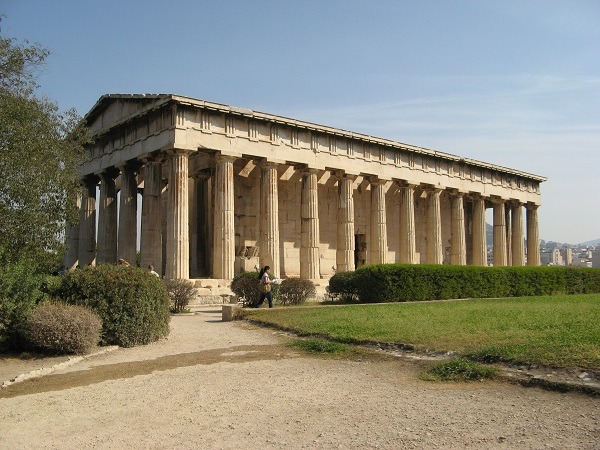Constructed two years before the renowned Parthenon, the Temple of Hephaestus is a Doric temple, the best and most beautifully preserved structure Greek structure in the world. It was dedicated to the ancient god of fire Hephaestus and the patron of arts and pottery Athena. Pericles, an Athenian politician, sponsored the project, and while an unknown architect took over the design.
Often referred to as the Theseum, it was initially believed that the temple was a hero shrine erected for Theseus. However, the Athena and Hephaestus’ cult status disproved the designation. Different eras saw the temple maintained and used for various purposes before it was returned to its status as an ancient building in 1934.
History and Construction
After the victory in the Battle of Plataea, the last land clast during Persia’s second seizure of Greece, the Greeks promised not to restore any of the sanctuaries for them to serve as lasting remnants of the war. Instead, Athenians decided to use all their resources in reviving the economy and established their presence and power in the Delian League, the alliance of Greek cities formed to free the eastern region from the Persian rule and protect all from Persia’s retaliation.
During Athen’s golden age, Pericles came into power and became responsible for the empire’s full development. One of his visions was revolutionizing the city and making it Greece’s center of culture and power. Part of this was the construction of the Temple of Hephaestus in 449BC, in which progress was slowed down by about three decades as the Parthenon was prioritized, getting the funds and manpower. In 445-400 BC, the western frieze was finished while the eastern frieze and other modifications in the building’s interior for the stylistic ground were completed around 435-430 BC. Cult images and the roof was only finished in 421-415 during the Peace of Nicias. In 416-415 BC, the Temple of Hephaestus was officially inaugurated in Athens.
Temple of Hephaestus’ Design
The Temple of Hephaestus is situated on Kolonos Hill and provides a scenic view of the Agora. It is erected on an elevated platform, spanning 45 feet wide and 104 feet long. The building was erected using Pentelic marble quarried from Mount Pentelicus. Meanwhile, the sculptures were made using Parian marble from the island of Paros. Other parts used terracotta (roof tiles), wood (ceiling), and limestone (platform’s base steps).
A Doric-style peripheral building accentuated by some Ionic facets, the temple features colonnades on all sides that surround an enclosure. Its interior is divided into different parts, the foretemple (pronaos), the inner shrine (cella), and a backside temple (opisthonaos). The enclosure’s eastern edge is left open, which permits the sun rays to light up the altar that stands on the inner shrine’s altar, which showcases the Hephaestus and Athena’s bronze statues.
In the exterior, the thick, horizontal elements sit atop the columns called friezes. These friezes are then adorned by triglyphs and metopes, with the former characterized by three verticals lines, while is a panel that showcases a scene from Greek’s history. Temple of Hephaestus’ friezes highlighted the Pallantids, Labors of Hercules, Labors of Theseus, Battle of the Lapiths and Centaurs, and the Battle of Theseus.
Recent History
From the 7th century, the Temple of Hephaestus found another purpose, serving as an Orthodox church devoted to Saint George Akamatus. It also served as the burial grounds during the 19th century for non-Orthodox Europeans. The last Holy Mass was held on February 21, 1833, during the arrival of Otto the Great in Greece.
In 1834, the building was converted into a museum and remained as such for a century. It was only in 1934 when it was returned to its designation as a historical site and when it was granted to undergo vast archeological research. Today, the fantastic temple serves as a great piece of Dorian architecture and a memento of Greek’s rich past. This style and design has inspired many styles including colonial, modern and many others.

